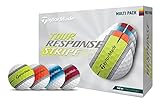Testing the hardness of golf balls can be done by using a tool called a durometer. A durometer is a device that measures the hardness of a material by applying a specific amount of pressure to the surface. To test the hardness of a golf ball, the durometer is pressed against the surface of the ball with a consistent amount of force. The durometer will then give a reading indicating the hardness of the golf ball.
Another method to test the hardness of golf balls is by conducting a drop test. In this test, a golf ball is dropped from a specific height onto a hard surface and the rebound height is measured. The higher the rebound height, the harder the golf ball is considered to be.
It is important to test the hardness of golf balls as it can affect the performance of the ball on the golf course. A softer ball may compress more upon impact, leading to reduced distance, while a harder ball may travel farther but offer less control.
Ultimately, testing the hardness of golf balls can help golfers determine which type of ball is best suited to their playing style and preferences.
How to measure the hardness of golf balls with different dimple patterns?
One common method to measure the hardness of golf balls with different dimple patterns is the compression test. This test involves applying a specific amount of force to the golf ball and measuring how much the ball compresses under that force.
To perform a compression test on golf balls with different dimple patterns, you would first need a compression tester, which is a device specifically designed for this purpose. You would then place each golf ball on the compression tester and apply a standardized amount of force to the ball. The amount of compression would then be recorded on a scale, with higher compression values indicating a harder golf ball.
It is important to perform the compression test on each golf ball multiple times to ensure accurate and consistent results. Additionally, make sure to use the same amount of force and testing conditions for each ball to eliminate any variables that could affect the results.
Another method to measure hardness is the durometer test, which measures the hardness of a material by assessing its resistance to indentation. This test involves using a durometer gauge to measure the hardness of the outer cover of the golf ball. The higher the durometer reading, the harder the cover of the golf ball.
Both the compression test and the durometer test can provide valuable insights into the hardness of golf balls with different dimple patterns, allowing you to make informed decisions when selecting the right ball for your game.
How to ensure accurate results when testing the hardness of golf balls?
- Use a reliable hardness tester: Ensure that you are using a high-quality hardness tester that is specifically designed for golf balls and capable of providing accurate and consistent results.
- Calibrate the hardness tester: Regularly calibrate the hardness tester according to the manufacturer's instructions to ensure accurate measurements.
- Control environmental factors: Maintain a consistent temperature and humidity level in the testing area to prevent fluctuations that could affect the hardness readings.
- Follow a standardized testing procedure: Develop a standardized testing procedure and ensure that all tests are conducted in the same manner to minimize variability in results.
- Test multiple samples: To account for any potential variations in manufacturing, test multiple samples of the same type of golf ball and calculate an average hardness value.
- Record and analyze results: Keep detailed records of all testing results and analyze the data to identify any trends or inconsistencies that may need further investigation.
- Verify results: Verify the hardness results by comparing them to the manufacturer's specifications or using additional testing methods to confirm accuracy.
- Seek expert advice: If you have any doubts or concerns about the accuracy of your hardness testing results, consult with a materials testing expert or the golf ball manufacturer for guidance.
How to test the hardness of golf balls with different core materials?
One way to test the hardness of golf balls with different core materials is to use a durometer, which is a device used to measure the hardness of materials. The following steps outline how to perform this test:
- Choose several golf balls with different core materials that you want to test.
- Place the golf ball on a stable surface.
- Hold the durometer perpendicular to the surface of the golf ball, making sure that the indenter on the durometer is in contact with the surface of the ball.
- Apply pressure to the durometer until the indenter penetrates the surface of the golf ball.
- Note the hardness reading on the durometer for each golf ball tested.
- Repeat the test for each golf ball with different core materials.
- Compare the hardness readings to determine which core material is the hardest.
It is important to note that the hardness of a golf ball can affect its performance on the course, so conducting this test can help you determine which type of core material is best suited for your game.









